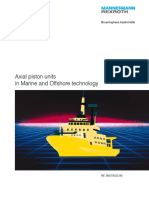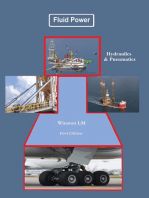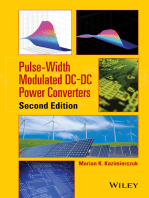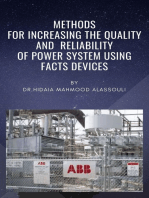Hydraulic-Electric Analogies:: Hydraulic Power Conversion, Part 2
Hydraulic-Electric Analogies:: Hydraulic Power Conversion, Part 2
Uploaded by
Anonymous erirwceCopyright:
Available Formats
Hydraulic-Electric Analogies:: Hydraulic Power Conversion, Part 2
Hydraulic-Electric Analogies:: Hydraulic Power Conversion, Part 2
Uploaded by
Anonymous erirwceOriginal Description:
Original Title
Copyright
Available Formats
Share this document
Did you find this document useful?
Is this content inappropriate?
Copyright:
Available Formats
Hydraulic-Electric Analogies:: Hydraulic Power Conversion, Part 2
Hydraulic-Electric Analogies:: Hydraulic Power Conversion, Part 2
Uploaded by
Anonymous erirwceCopyright:
Available Formats
Motion Control
JACK L. JOHNSON | Contributing Editor
Hydraulic-Electric Analogies:
Hydraulic Power
Conversion, Part 2
Power generated by hydraulic systems exhibits current flow traits similar to those
of its electrical counterparts. Load
(output)
IT IS NOW just a simple step to make the pump illustrated in Fig. cylinder
4 from Part 1 (“Hydraulic-Electric Analogies: Hydraulic Power Pressure
Conversion, Part 1” on hydraulicpneumatics.com) into one that gauge
receives mechanical input power via a rotating shaft instead of Check
the reciprocating, manually operated handle. The changes are valves
shown in Fig. 5. Rotation center
The cam has a simple circular shape, but its rotational axis CV3 Cam CV1
is offset from the circle’s center. It generates the required recip- Release
rocating motion to the pumping pistons. The circular cam also valve
Pumping Rotation
imparts sinusoidal motion to the pumping pistons. pistons
CV4 CV2
An additional change is that the blank end chambers of the
pumping pistons have been outfitted with return springs. In the
configuration shown, they are essential to ensure that the piston 5. When the reciprocating handle is replaced with a rotating cam, the
rods remain in contact with the cam at all times and provide pump can receive simple rotational input power from a conventional
return motion to the pistons, ensuring that they will fill with res- prime mover.
ervoir fluid while retracting. The earlier versions of the described
pump both engage the link between the input handle and the configurations arrange the multiple pistons axially, making for a
pumping pistons with a pin and slot, which ensures that the smaller-diameter machine.
pumping pistons will follow the handle motion.
The most important feature of the pump in Fig. 5 is that it can CHECK-BALL PUMPS
be driven by a rotating machine. Another key point is that more Another variation is to use a cam with more than one lobe, so
than two pumping pistons can be incorporated, up to the num- that there will be two pumping cycles per shaft rotation, doubling
ber permitted by the physical size limitations and the strength the output flow in a given package size. In commercial con-
required of the machine and its structural parts. figurations, the inlet check valves are often embedded within the
In the configuration shown, the multiplicity of pistons would pumping pistons, making a more-compact machine. They are
be arranged radially, with the one cam providing the rotary-to- referred to as check-ball or check-valve pumps.
reciprocating motion conversion. Multi-piston pumps usually An important limitation of the check-ball pump is that it can-
have an odd number of pistons, because it’s been demonstrated not operate as a motor. To understand this reality, imagine that
that it will produce the lowest outlet pressure ripple and, thus, the rotational shaft is free from any constraints, and then one
the lowest noise. Although the example pumps have pistons pushes downward with great force on the output piston rod. That
arranged radially outward, the majority of commercial pump force—no matter how great—cannot be brought to bear on the
18 DECEMBER 2015 HYDRAULICS & PNEUMATICS
Motion Control
pumping pistons because of the check valves (CV3 and CV4). Therefore, it precludes
any hope of pressure at the output port resulting in shaft rotation. In this case, there’s no SPECIAL OFFER
direct analogous kind of electrical motor. FOR H&P READERS:
The next part of this series will reveal that certain pump designs function very well BUY ONE, GET ONE
as motors, and motors that run well as pumps. In fact, in many applications, pumps and
motors constantly switch from pumping to motoring and vice versa upon the occurrence BUY A COPY of
of accelerations and decelerations. The conventional piston pump that uses a port plate as Electrohydraulic
the ac-dc commutation function is a machine that can both pump and motor. Control of Pressure
and Cylinder Force
before Jan. 15,
For heavy duty
markets including 2016, and get a
Construction, copy of Basic
Mining, Marine,
Of-Shore, Electronics
Hose & Tube for Hydraulic Motion
Assembly
Control for free. It
contains extensive coverage of electronic
Hose, Tube, Pipe Cleaning & Sealing Solutions feedback and control, with emphasis on
hydraulics technology. This hardbound text
Say goodbye to caps & plugs. Now there’s a better solution!
is a must for anyone considering certifica-
tion as a fluid-power engineer.
Electrohydraulic Control of Pressure and
Clean Seal System Cylinder Force contains useful information
of the background theory and pertinent
derivations regarding the design and analy-
sis of controlling pressure by electrohy-
draulic servo and proportional valves.
Control of pressure is vital to controlling
force or torque from actuators. It is subject
to the constraints of the system nonlineari-
ties. This book presents all the mathemati-
cal wizardry needed to design effective,
predictable, and controllable
electrohydraulic systems. It introduces
Hand-held heat guns and difusers available.
ways to control gauge and differential pres-
sure and also covers the problems associ-
ated with control of cylinder output force.
Advancing Contamination Control It is a necessary library addition for any
Durable heat-shrink seal • Quick, clean, easy process • Universal ft engineer who intends to design pressure-
Short capsules available to conform to 90° fttings control loops or force control loops, and is
written for the third- or fourth-year under-
LEARN MORE at www.ultracleantech.com graduate engineering student.
The 220-page textbook sells for $69. To
order, go to www.hydraulicspneumatics.
com/Bookstore-0, browse through the
Seal Easy. titles, fill out the interactive PDF order form,
.
Clean Easy and e-mail, fax, or mail the form to us.
FOR MORE INFORMATION about
1274
274 Highway 7
77
77, Bridgeton, NJ 08302 U.S.A the book or to ask a question about
800-791-9111 • 856-451-2176 •Int’l +1 856-391-3262 its content, e-mail the author at
Email: sales@ultracleantech.com jack@idaseng.com.
Hose, tube and pipe cleaning and sealing solutions.
20 DECEMBER 2015 HYDRAULICS & PNEUMATICS
You might also like
- Chrysler New Yorker 1988 1989 1990 1991 1992 1993 Repair Service Manual FREE PDF DOWNLOADDocument40 pagesChrysler New Yorker 1988 1989 1990 1991 1992 1993 Repair Service Manual FREE PDF DOWNLOADsen til75% (4)
- Cummins ISB and QSB Service Manual Volume 2Document690 pagesCummins ISB and QSB Service Manual Volume 2hafiz94% (33)
- Practical Guides to Testing and Commissioning of Mechanical, Electrical and Plumbing (Mep) InstallationsFrom EverandPractical Guides to Testing and Commissioning of Mechanical, Electrical and Plumbing (Mep) InstallationsRating: 4 out of 5 stars4/5 (4)
- SYM Mio50 Service Manual 000Document215 pagesSYM Mio50 Service Manual 000Restu PebrianaNo ratings yet
- EV100LX Instructions With EV200 SupplementDocument81 pagesEV100LX Instructions With EV200 SupplementAlexandre Batista100% (1)
- Fig. 3 Hydraulic System of Hydraulic Excavator: OperationDocument1 pageFig. 3 Hydraulic System of Hydraulic Excavator: OperationmargaretevansNo ratings yet
- SPL: 25447 Simplified Computer-Aided Analysis of Electrical Current in Motors Used For Beam Pumping SystemsDocument14 pagesSPL: 25447 Simplified Computer-Aided Analysis of Electrical Current in Motors Used For Beam Pumping SystemsJosé TimanáNo ratings yet
- Hydraulic Component ModellingDocument18 pagesHydraulic Component ModellingRajesh MalikNo ratings yet
- Variable Speed Pumping A Guide To Successful Applications PDFDocument22 pagesVariable Speed Pumping A Guide To Successful Applications PDFGilberto Sanchez100% (1)
- ISA AW 2012 Control Valve Vs Variable Speed Drive PDFDocument10 pagesISA AW 2012 Control Valve Vs Variable Speed Drive PDFDavid Omar Torres GutierrezNo ratings yet
- PR 9020221Document13 pagesPR 9020221LUIS ENRIQUE MANUEL VILLACORTA CALLENo ratings yet
- PumpsDocument5 pagesPumpsMonicaa BautistaNo ratings yet
- Valve Actuator Selection GuideDocument3 pagesValve Actuator Selection GuideBramJanssen76100% (1)
- Application Center Tractors: Head: Uwe MaierDocument16 pagesApplication Center Tractors: Head: Uwe MaierStar SealNo ratings yet
- The Gentle Giant of NiederaussemDocument6 pagesThe Gentle Giant of Niederaussemjayesh gohilNo ratings yet
- Fluid Coupling NotesDocument13 pagesFluid Coupling NotesDSKNo ratings yet
- PB 0101 Rev 2Document16 pagesPB 0101 Rev 2gk218No ratings yet
- 4.2 Water PumpDocument8 pages4.2 Water PumpPRATIKNo ratings yet
- Aerial e PDFDocument6 pagesAerial e PDFJMNo ratings yet
- Sarver Pump SizingDocument10 pagesSarver Pump SizingRajendraNo ratings yet
- MN4051 0322Document8 pagesMN4051 0322Dênis DáyolNo ratings yet
- Choose Between Long-Stroke Sucker Rod Pumping Systems.: September 2015Document5 pagesChoose Between Long-Stroke Sucker Rod Pumping Systems.: September 2015Mohanad HussienNo ratings yet
- Whitepaper: Using Power Sensing To Monitor and Protect PumpsDocument8 pagesWhitepaper: Using Power Sensing To Monitor and Protect PumpscruzleenoNo ratings yet
- Whitepaper: Using Power Sensing To Monitor and Protect PumpsDocument8 pagesWhitepaper: Using Power Sensing To Monitor and Protect Pumpsashumishra007No ratings yet
- Reliable Technology For Continuous Operation: Technical DescriptionDocument12 pagesReliable Technology For Continuous Operation: Technical DescriptionPaola Armas100% (1)
- U15 Ce 1007Document23 pagesU15 Ce 1007mubara marafaNo ratings yet
- Pump NetworksDocument9 pagesPump NetworksArunkumarNo ratings yet
- Seminar Report ON "Solar Pump"Document32 pagesSeminar Report ON "Solar Pump"api-19775783100% (2)
- Lecture 1 ElectrohydraulicsDocument62 pagesLecture 1 ElectrohydraulicsAhmedNo ratings yet
- Axial Piston Pump 2Document8 pagesAxial Piston Pump 2Eslam MansourNo ratings yet
- Application Chart For Various Turbine TypesDocument18 pagesApplication Chart For Various Turbine TypescortforceNo ratings yet
- Energies 15 05496Document15 pagesEnergies 15 05496apis21No ratings yet
- MCT 2Document3 pagesMCT 2Sylesh SreehariNo ratings yet
- Table 1 Engine Specifications: 4 Engine Model Simulation and Analysis For VVTDocument14 pagesTable 1 Engine Specifications: 4 Engine Model Simulation and Analysis For VVTDolovan DsNo ratings yet
- Cálculo BombasDocument10 pagesCálculo BombasCatalina AcevedoNo ratings yet
- Numerical and Experiential Study of Motion Control Using Pressure FeedbackDocument7 pagesNumerical and Experiential Study of Motion Control Using Pressure Feedbackgil lerNo ratings yet
- Reading Material CH 12 Sucker Rod PumpingDocument22 pagesReading Material CH 12 Sucker Rod PumpingSagar DadhichNo ratings yet
- Camless Engines A New Approach in I.C.Engines: Sushma - Annavarapu@yahoo - Co.inDocument11 pagesCamless Engines A New Approach in I.C.Engines: Sushma - Annavarapu@yahoo - Co.inmicmechNo ratings yet
- AKOSDocument11 pagesAKOSBoniphace JohnNo ratings yet
- Simulador Qrod v3 para Bombeo MecanicoDocument3 pagesSimulador Qrod v3 para Bombeo MecanicobeymarNo ratings yet
- Pump DesigningDocument12 pagesPump DesigningFaizal MohammedNo ratings yet
- SSEG-003 ElecGlycolConversion WebDocument4 pagesSSEG-003 ElecGlycolConversion WebAnonymous bHh1L1No ratings yet
- Fachaufsatz 2014 02-gbDocument6 pagesFachaufsatz 2014 02-gbGoutham KSNo ratings yet
- Pump Life Cycle Cost 8 Energy Cost ReductionDocument31 pagesPump Life Cycle Cost 8 Energy Cost ReductionRafael OrjuelaNo ratings yet
- Ecway Technologies: Design and Fabrication of Portable Port Type Intragrated Hydraulic Bearing Press (Capacity 7ton)Document4 pagesEcway Technologies: Design and Fabrication of Portable Port Type Intragrated Hydraulic Bearing Press (Capacity 7ton)Vicky SuryawanshiNo ratings yet
- Cargador Cat 950 PDFDocument35 pagesCargador Cat 950 PDFjorge soto a.100% (2)
- D S Henderson Napier University, UK.: Variable Speed Electric Drives - Characteristics and ApplicationsDocument8 pagesD S Henderson Napier University, UK.: Variable Speed Electric Drives - Characteristics and ApplicationsscrsanNo ratings yet
- Chapter - 1. Introduction and Scope of Work: 1.1 Introduction To Axial-Piston PumpsDocument8 pagesChapter - 1. Introduction and Scope of Work: 1.1 Introduction To Axial-Piston PumpsChandra SekaranNo ratings yet
- Hi EdlDocument8 pagesHi EdljargiaNo ratings yet
- Couplings: Torque Converters and HydraulicDocument2 pagesCouplings: Torque Converters and Hydraulicajkbro8No ratings yet
- Simulation in Turbine GoverningDocument4 pagesSimulation in Turbine GoverningChannaNo ratings yet
- Unit - 2 HPDocument72 pagesUnit - 2 HPVasanth MemoriesNo ratings yet
- Choose Between Current Long-Stroke Sucker Rod Pumping SystemsDocument4 pagesChoose Between Current Long-Stroke Sucker Rod Pumping SystemsNevada Saga SusenoNo ratings yet
- SKshah Unit 2Document35 pagesSKshah Unit 2Neelesh SahuNo ratings yet
- Mechanical Equipment: Nuclear Training Course 23001 (NEIT 230.1)Document59 pagesMechanical Equipment: Nuclear Training Course 23001 (NEIT 230.1)abuhurairaqazi100% (2)
- How to Select the Right Centrifugal Pump: A Brief Survey of Centrifugal Pump Selection Best PracticesFrom EverandHow to Select the Right Centrifugal Pump: A Brief Survey of Centrifugal Pump Selection Best PracticesRating: 5 out of 5 stars5/5 (1)
- Reference Guide To Useful Electronic Circuits And Circuit Design Techniques - Part 1From EverandReference Guide To Useful Electronic Circuits And Circuit Design Techniques - Part 1Rating: 2.5 out of 5 stars2.5/5 (3)
- Methods for Increasing the Quality and Reliability of Power System Using FACTS DevicesFrom EverandMethods for Increasing the Quality and Reliability of Power System Using FACTS DevicesNo ratings yet
- AOC Industrial SeriesDocument4 pagesAOC Industrial SeriesMARCO HernándezNo ratings yet
- Mercomax 07-12-2021Document362 pagesMercomax 07-12-2021Juan Ignacio OlariNo ratings yet
- Daytona DPUL27 27pce Press & Pull Sleeve KitDocument1 pageDaytona DPUL27 27pce Press & Pull Sleeve Kitanndrew0No ratings yet
- CAN Bus and OBD-IIDocument4 pagesCAN Bus and OBD-IISirleh SalehNo ratings yet
- Web41095 718389Document2 pagesWeb41095 718389Jesus C. MedinaNo ratings yet
- Johnson Outboard Power PacksDocument6 pagesJohnson Outboard Power PacksJSMarine Parts ChinaNo ratings yet
- Power Apparaus SyllabusDocument1 pagePower Apparaus SyllabusADINo ratings yet
- 1731 05 - Kartu PerkalianDocument1 page1731 05 - Kartu Perkalianchachakuswara31No ratings yet
- Tatra T815-7 PDF Technical SpecificationsDocument8 pagesTatra T815-7 PDF Technical SpecificationsSanjayNo ratings yet
- Ant-Lock Brake System (ABS) PicantoDocument2 pagesAnt-Lock Brake System (ABS) PicantoHuy Trần QuốcNo ratings yet
- Pala O&KRH90CDocument7 pagesPala O&KRH90Cmchan1965100% (1)
- Why Compressors Fail?Document83 pagesWhy Compressors Fail?Neil LachicaNo ratings yet
- 6B5.9-C (CPR252)Document2 pages6B5.9-C (CPR252)Dennis K ThomasNo ratings yet
- Use QR Code QR Code To VERIFY Paper: Auction List ExplanationDocument2 pagesUse QR Code QR Code To VERIFY Paper: Auction List ExplanationSultan KhanNo ratings yet
- Maintenance Schedule ChartDocument3 pagesMaintenance Schedule Chartkarubanga wycklifNo ratings yet
- Dat 444 Ipu Tcae3 Stage 4Document4 pagesDat 444 Ipu Tcae3 Stage 4haiderNo ratings yet
- Enhancing Home SecurityDocument3 pagesEnhancing Home SecurityCODE SAFENo ratings yet
- Daimler Hydrogen TrucksDocument3 pagesDaimler Hydrogen TrucksfereNo ratings yet
- Cobalt Boats: Owner's ManualDocument130 pagesCobalt Boats: Owner's ManualCarlos RoweNo ratings yet
- 03 P21 Hydraulic Components - Without-LogoDocument59 pages03 P21 Hydraulic Components - Without-LogoSócrates LandeNo ratings yet
- NHTSA 2015 0055 0109 - Attachment - 1Document2 pagesNHTSA 2015 0055 0109 - Attachment - 1fixvarlexNo ratings yet
- Unit 2 Fuel System For SI & CI EngineDocument76 pagesUnit 2 Fuel System For SI & CI EnginedemoNo ratings yet
- Renault 4L - PR901Document212 pagesRenault 4L - PR901João MiguelNo ratings yet
- Assembly and Parts Drawing IG2600: 3KW Generator KD (M) 30 (A) - 02000 Control Panel Assembly KGE3000Ti-13100Document6 pagesAssembly and Parts Drawing IG2600: 3KW Generator KD (M) 30 (A) - 02000 Control Panel Assembly KGE3000Ti-13100Youssef BeheryNo ratings yet
- Brainkart 1NQKLHuNY5E 83rhvrbqCeQMF4f5KTkGz - pdf-1Document16 pagesBrainkart 1NQKLHuNY5E 83rhvrbqCeQMF4f5KTkGz - pdf-1Revanth RamineniNo ratings yet
- Awm PM Agreement - Feb 2022Document11 pagesAwm PM Agreement - Feb 2022Darryl GrossauerNo ratings yet
- BS Iso 39001-2012Document54 pagesBS Iso 39001-2012hamad100% (3)

























































































